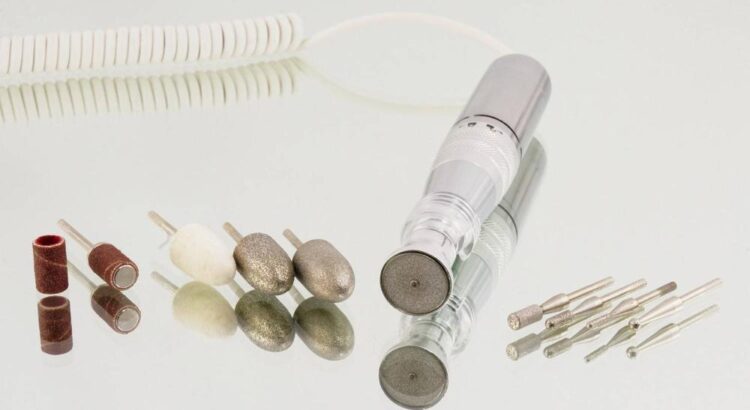Aktualizacja 26 January 2023
How to choose the perfect podiatry heel cutters? Podology milling cutters, otherwise known as rotary tools, are the basic equipment of the workplace of a podiatrist who has a lot of knowledge in the field of medicine, cosmetology and dietetics. A podiatry clinic must be equipped with specialized tools to perform complex treatments and at the same time ensure the safety of clients. The market offers a wide selection of podology cutters, which is why choosing them is not easy.
Division of podiatry cutters
Due to the function they perform, podology cutters are divided into three basic groups: nail cutters, heel cutters and cuticle cutters. You can also make a division according to the type of treatment for which they are used, you can distinguish, among others, cutters for:
– grinding nails, cuticles,
– shaping thickened nails,
– removing calluses on the soles,
– removing calluses on shafts,
– removing cuticles
, removal of excessive epidermis from the skin of heels,
– removal of calluses and corns,
– development of a diabetic’s foot.
Another distinction concerns the material from which the cutters are made, they can be stone, cemented carbide, ceramic, diamond, or steel.
- http://www.elmon.pl/srebrna-bizuteria-zawsze-na-czasie
- https://www.bankowe.net.pl/co-to-jest-alkoholizm/
- https://www.ujoasi.pl/seo-we-wroclawiu/
Heel care cutters
One of the classifications divides milling cutters according to the area of work they deal with. Some of the cutters are especially suitable for foot care. First of all, these are diamond cutters made of hard and extremely solid stainless steel. A characteristic feature of diamond milling cutters is the lack of visible cuts. The cutting element is placed on the top of the cutters in the form of diamond filings. Depending on the grit thickness, diamond cutters are divided into: very fine, fine, medium, coarse and very coarse. The first three types are used for grinding, among others, heel skin. Others are used when it is necessary to remove calluses or develop thickened nails.
Steel cutters, on the other hand, can be divided into rosettes and vacuum cutters. The podiatrist usually uses rosettes to shallow clefts and remove warts. Vacuum cutters are used to remove calluses and calluses on the heels. Some specialists working in the podiatry clinic call vacuum cutters trephines, they come in two types, with a crown and flat, with a scalpel.
Carbide cutters, i.e. sintered carbide cutters, are very hard and resistant to external factors, but if used improperly, they can do more harm than help. Using them requires experience, so they should be used by an experienced podiatrist. Different types of tip shapes are available. Tips of point-shaped milling cutters are used during the treatment of heel skin cleansing. The balls and tears enable the treatment of cuticles and the removal of corns, the tears precisely remove and cut calluses on the nails of the feet. The cylindrical tips perfectly remove calloused skin from the heels.
Ceramic cutters, which have similar properties to sintered carbide, are used in a similar way. Zirconium oxide is used to produce them, which is also used in prosthetics and dentistry. It is characterized by exceptional hardness, but at the same time it is very brittle. You have to be very careful when using it, because if it falls from even a small height, it can crumble.
Stone cutters are also widely used in podiatry. They are made of medium grit stone and can be used wet or dry, but to ensure maximum use, place them as far into the center of the router as possible. They are mainly used for grinding and smoothing the heel skin.
Appropriate parameters of podological equipment
When completing the perfect set of podology cutters, the podiatrist is largely guided by the convenience and usefulness of their use. You should also pay attention to their parameters so that they are compatible with the dimensions of the milling machine used in the podology clinic. The rotation range of the milling machine should also be matched to the rotation of the cutters, because some of them have a specific rotational height in which they can be used. You should also pay attention to the size of the arbor, some routers are stocked with a non-standard size in this regard.
What is the difference between a podological pedicure and a cosmetic pedicure?
The podiatrist works with other doctors, e.g. a dermatologist, after a thorough examination of the foot, he makes a diagnosis. Using properly selected tools, such as a scalpel or podiatry milling machine, he deals with various changes on the feet. It can burn warts, remove calluses, and treat psoriasis, ingrown toenails, and other foot conditions. The visit can take up to an hour and a half.
The beautician cleans and cares for the skin of the feet. He removes the epidermis from the heels, takes care of trimming and painting nails. A cosmetic pedicure is performed only on healthy feet and lasts about half an hour.








